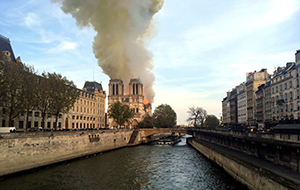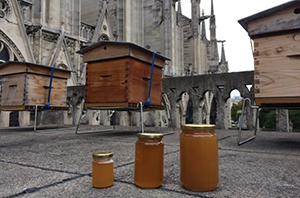Bee Hives Had Been a Part of Notre Dame's Roof for the Past Several Years
By: Emily Nason
Posted on:04/17/2019 Updated:06/18/2019The fire at Notre Dame has eradicated the hives, that were placed there in 2013
 It's no wonder that less than 12 hours after the Notre Dame caught fire on Monday, billionaires are already clamoring to contribute to its restoration. The cathedral is not only one of Paris's most beloved landmarks, but a paradigm of Gothic architecture—and one that dates back to the 1100s at that.
It's no wonder that less than 12 hours after the Notre Dame caught fire on Monday, billionaires are already clamoring to contribute to its restoration. The cathedral is not only one of Paris's most beloved landmarks, but a paradigm of Gothic architecture—and one that dates back to the 1100s at that.
Fret not: Notre Dame has since been declared "structurally sound." (After all, it's survived much more than that before, from decades of neglect—at least until Victor Hugo came to its rescue—to Adolf Hitler's threat of demolition.) Now that it's thankfully here to stay, study up on some of the lesser-known reasons as to why the cathedral has come to be regarded as a national—and international—treasure.
It Started Off as a Center for Paganism
Construction on the cathedral began in 1163, though it didn't wrap up until long after; while the towers were completed in 1245, it wasn't until the 19th century that it got its central spire. But Parisians weren't the only ones to transform where it stands on the Île de la Cité: It was first home to a pagan temple, which Romans built after Julius Caesar led them to occupy the city in 52 BC.
It's the literal center of Paris.
It might be tricky to find amidst all the tourists, but the concrete outside the cathedral features a brass plate that marks Paris's "point zero," or the city's supposed center. Of course, it's a center in other ways, too: The Eiffel Tower may have taken over its towers' title of the city's tallest structure in the 1930s, but Notre Dame still receives nearly double the number of visitors.
It was home to a thriving community of altruistic honeybees.

Did you know that in 2013, a hive of honey-producing bees was placed on the roof of the Notre Dame (i.e., the room where the priest prepares for a service). The types of bees—Buckfast bees—were bred from a special strain at a Benedictine monastery, and known for their gentleness. The original mission was to preserve the dynamic biodiversity of the French capital. The clergy of the famous cathedral urged city-dwellers to reflect upon the beauty of creation and our fundamental responsibility towards nature, as custodians of the Earth.
Placing bees in such an urban environment draws attention to the more serious issue of the collapse of bee colonies. Climate change, pesticides, and lack of biodiversity, have made it more and more difficult for bees to thrive. Ironically cities have become their refuge. The beehives that were once hosted on the roof on Notre Dame were placed there to “recall the beauty of the Creation and responsibility of man towards it.” Before the fire, Paris was home to over 700 official beehives. Much of the honey produced by the bees ends up being given to the poor people of the city.
 Sign In
Sign In
 Sign In
Sign In
